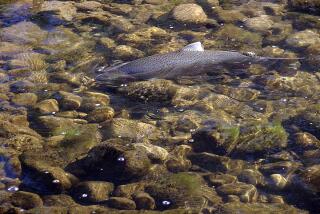New report shows improving U.S. fishing management, but is it enough?
Here’s more evidence that you can manage your way out of a bad situation. This week the National Oceanographic and Atmosphere Administration’s annual census of commercial fisheries that were either already overfished or in danger of becoming overfished dropped to its lowest number since it was started in 1997.
Add that to the improving of the status of Pacific rockfish on the Monterey Bay Aquarium’s Seafood Watch list last month and this has been a very good spring for seafood lovers — at least as far as American fisheries are concerned.
But with as much as 90% of the seafood Americans consume coming from overseas, problems certainly remain.
“The United States does a very good job of managing its fisheries,” says Jerry Schubel, president and chief executive of the Aquarium of the Pacific in Long Beach. “We have done a really good job. There’s still lots of work to do, but all the trends are in the right direction and we should be very proud.
“The other part, though, that we can’t lose sight of: Those regulations only go out 200 miles and many of the stocks that are fished are fished in international waters by other countries that don’t have same commitment to sustainable stocks that we do.”
The NOAA report to Congress removed two fish stocks from the “overfished” category: gag grouper in the Gulf of Mexico and North Atlantic albacore. It also reported improvements in the status of four more fish stocks from the “overfishing” list that had been considered in danger of becoming overfished – snowy grouper in the southern Atlantic, haddock in the Gulf of Maine, various species of jacks in the Gulf of Mexico and bluefin tuna in the western Atlantic.
A stock is considered overfished when the population is too low for any reason, including overfishing but also including environmental factors. It is on the “overfishing” list when too many of them are being caught.
Four stocks were added to the “overfishing” category: gray triggerfish and greater amberjack from the Gulf of Mexico, and various scups, porgies and wrasses from Puerto Rico.
On the West Coast, four fish are still considered overfished: canary and yelloweye rockfish, Pacific Ocean perch and Pacific bluefin tuna.
Overall, 37 fish stocks around the U.S. are considered overfished (16% of the total) and 26 are on the “overfishing” list (8%). In 2007, 24% were considered overfished and 17% were given “overfishing” status.
Three other fish populations — Gulf of Maine/Cape Hatteras butterfish, Gulf of Mexico gag grouper and mid-Atlantic Coast golden tilefish — were found to have rebuilt to target levels, bringing the total of rebuilt stocks to 37 since 2000.
“This report illustrates that the science-based management process under the Magnuson-Stevens Act is working to end overfishing and rebuild stocks,” Assistant NOAA Administrator Eileen Sobeck said in a release.
“While we have made tremendous progress, we know there’s more work to be done – especially as we continue to document changes to our world’s oceans and ecosystems.”
Schubel agrees.
“We still have lot of work to do,” he says. “There are still a lot of fisheries that are overfished, there is still a lot of environmental damage being done by bottom trawling, and bycatch [fish that are caught unintentionally when fishing for something else] is still a huge problem.
“This is a song that I keep playing over and over again and it’s a little controversial, but let’s get sensible about farming the ocean. We’re not going to meet the demands of a growing population by having more boats go out and catch more fish. We’re only going to meet demand by responsible ocean aquaculture -- not to replace the fishermen, but to supplement them.”
Are you a food geek? Follow me on Twitter @russ_parsons1
More to Read
Eat your way across L.A.
Get our weekly Tasting Notes newsletter for reviews, news and more.
You may occasionally receive promotional content from the Los Angeles Times.







